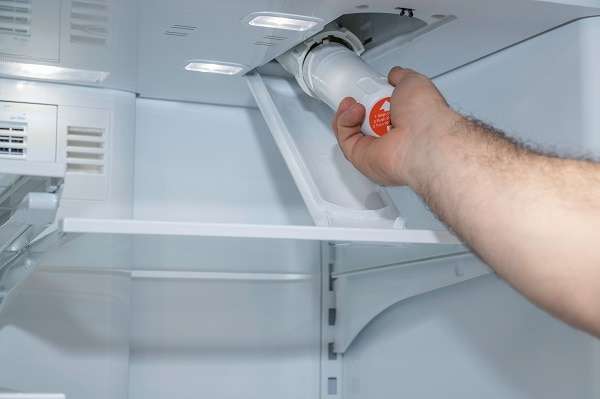A whirlpool refrigerator leaking water from ice dispenser can be a frustrating and perplexing problem, often leading to soggy floors and wasted water. Many homeowners initially assume the issue is a major malfunction, envisioning costly repairs or even replacement. However, in many cases, the culprit is a simple, easily rectified issue that can be resolved with a bit of troubleshooting and a few basic tools. Understanding the potential causes of a whirlpool refrigerator leaking water from ice dispenser is the first step to finding a solution and preventing further damage. Let’s explore the common reasons behind this common appliance woe.
Understanding the Common Causes
Several factors can contribute to water leaking from your Whirlpool refrigerator’s ice dispenser. Pinpointing the exact cause requires a systematic approach to eliminate potential problems;
- Clogged or Frozen Water Line: The water line supplying water to the ice maker can become clogged with mineral deposits or even freeze, leading to pressure buildup and eventual leaks.
- Faulty Water Inlet Valve: This valve controls the flow of water to the ice maker. If it’s cracked, damaged, or failing to close properly, it can cause a continuous drip.
- Cracked or Damaged Ice Maker Assembly: Physical damage to the ice maker itself can lead to leaks, especially if the cracks are located near water lines or dispenser components.
- Loose or Damaged Dispenser Components: The dispenser chute, auger, and other components can become loose or damaged over time, creating pathways for water to escape.
- High Water Pressure: Excessively high water pressure can overwhelm the ice maker’s components, leading to leaks and other malfunctions.
Troubleshooting and Solutions
Now that we’ve identified the potential causes, let’s explore some troubleshooting steps and potential solutions.
Checking the Water Line
First, inspect the water line connecting to your refrigerator. Look for kinks, bends, or signs of damage. Ensure the line is properly connected and secured. Consider replacing the water filter as a clogged filter can restrict water flow and contribute to freezing. If you suspect a frozen water line, try gently thawing it with a hairdryer or by letting the refrigerator warm up slightly.
Examining the Water Inlet Valve
The water inlet valve is typically located at the back of the refrigerator. Disconnect the power to the refrigerator before inspecting the valve. Look for cracks, leaks, or signs of corrosion. A multimeter can be used to test the valve’s solenoid for continuity. If the valve is faulty, it will need to be replaced.
Inspecting the Ice Maker Assembly
Carefully examine the ice maker assembly for any visible cracks or damage. Pay close attention to the areas around the water lines and dispenser components. If you find any cracks, the entire ice maker assembly may need to be replaced.
Addressing Dispenser Issues
Check the dispenser chute, auger, and other components for looseness or damage. Tighten any loose screws or connections. If any parts are damaged, they should be replaced. Also, ensure the dispenser door is sealing properly to prevent water from leaking out.
Regulating Water Pressure
Use a water pressure gauge to check the water pressure at the refrigerator’s water inlet. Ideally, the water pressure should be between 30 and 100 PSI. If the pressure is too high, you may need to install a pressure regulator.
Preventative Measures
Regular maintenance can help prevent future leaks and ensure your Whirlpool refrigerator operates smoothly. Here are a few tips:
- Replace the water filter every six months.
- Inspect the water line regularly for kinks or damage.
- Clean the ice maker periodically to remove mineral deposits.
- Adjust the water pressure if it’s too high.
Here’s the continuation of the text, formatted with HTML tags and adhering to the given instructions:
WHEN TO CALL A PROFESSIONAL
While many issues related to a leaking ice dispenser can be resolved with DIY troubleshooting, certain situations warrant professional assistance. If you are uncomfortable working with electrical components, or if you’ve tried the above solutions and the leak persists, it’s best to call a qualified appliance repair technician. Attempting repairs beyond your skill level can lead to further damage or even personal injury. Additionally, if your refrigerator is still under warranty, unauthorized repairs may void the warranty.
SIGNS YOU NEED PROFESSIONAL HELP:
– Persistent leaking despite troubleshooting.
– Visible electrical damage or sparking.
– Suspected refrigerant leaks.
– Lack of experience with appliance repair.
– Refrigerator is still under warranty.
UNDERSTANDING ICE MAKER CYCLES AND OPERATION
A basic understanding of the ice maker’s normal operation can also help you diagnose potential problems. The ice maker goes through a cycle of filling with water, freezing the water into ice cubes, and then ejecting the ice cubes into the storage bin. Any disruption to this cycle can result in water leakage; For example, if the ice maker is overfilling, it could be due to a faulty water inlet valve or a misadjusted fill level. If the ice isn’t ejecting properly, it could be due to a frozen ice maker or a faulty ejector arm.
COMPARATIVE ANALYSIS: COMMON LEAK CAUSES
To better understand the likelihood of certain issues, consider this comparative table of common leak causes:
Cause
Likelihood
Difficulty of Repair
Clogged Water Line
High
Easy
Faulty Water Inlet Valve
Medium
Medium
Cracked Ice Maker Assembly
Low
Difficult
Loose Dispenser Components
Medium
Easy
High Water Pressure
Low
Medium
Addressing a leaking ice dispenser promptly not only prevents water damage but also ensures your refrigerator operates efficiently, saving you money on energy bills. Remember to prioritize safety and consult a professional when needed.







